American Climate Action Goes Local
Air Date: Week of June 23, 2017
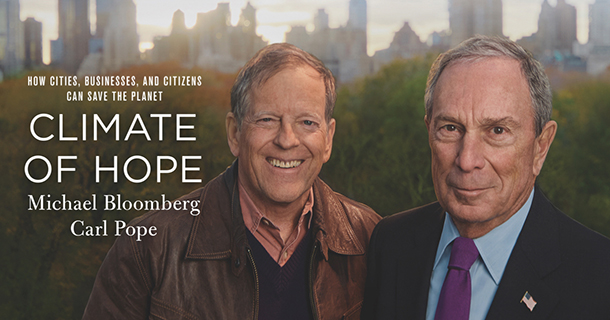
Carl Pope, the former Executive Director of the Sierra Club, and Michael Bloomberg, former New York City Mayor and currently the U.N. Special Envoy for Cities and Climate Change, co-authored the book Climate of Hope. (Photo: courtesy of Climate of Hope)
President Trump is ending U.S. participation in the Paris climate Agreement, but more than 1,000 U.S. governors, mayors, businesses, and universities say “Not so fast”. Their “We Are Still In” declaration pledges that subnational jurisdictions and private enterprise will act to meet the US commitments to the Paris agreement. Former NYC Mayor Michael Bloomberg’s top climate aide Carl Pope tells host Steve Curwood why this coalition expects to succeed.
Transcript
CURWOOD: From PRI and the Jennifer and Ted Stanley Studios at the University of Massachusetts Boston, this is Living on Earth. I’m Steve Curwood.
While the Trump-led federal government is moving to get out of the Paris Climate Agreement, more than a thousand local officials, including mayors and governors as well as business CEOs, are saying, “We’re Still In”. Former New York City Mayor Michael Bloomberg is among the prime movers of this coalition. He is now the U.N. Special Envoy for Cities and Climate Change, and his senior climate advisor is former Executive Director of the Sierra Club, Carl Pope.
Carl Pope joins me now, and, Carl, it’s great to talk with you again!
POPE: Wonderful to be with you again, Steve.
CURWOOD: So, this is a remarkable broad coalition of people representing vastly different interests. Who are some of the members?
POPE: At the moment we’ve got nine states, led by two of America's largest states, California and New York, over 150 cities, 1,500 businesses including big ones like Apple and little tiny ones like somebody's cookie shop in Manhattan. We've got 500 universities, and actually there's a separate group that came together independently but under exactly the same theme of 7,000 religious congregations - churches, synagogues, mosques, temples. It’s quite a remarkable coalition and it just kind of self-assembled in the three weeks it took Donald Trump to finally make the announcement that, I'm sure, he intended to make all along.
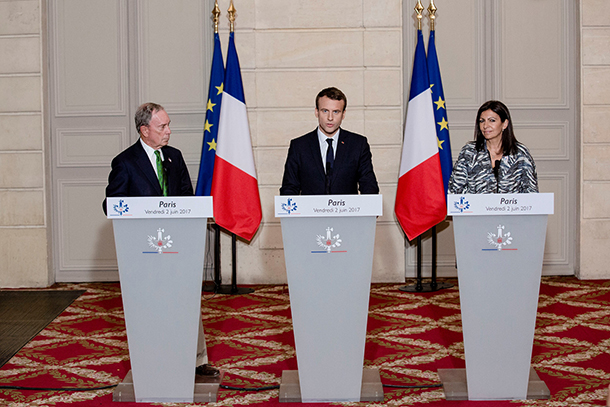
From left: Mayor Michael Bloomberg, French President Emmanuel Macron, and the Mayor of Paris, Anne Hidalgo at a joint press conference in the Élysée presidential palace on June 2nd, 2017. Bloomberg pledged to keep the U.S. a part of the Paris agreement through city, state, and business efforts. (Photo: courtesy of Mike Bloomberg)
CURWOOD: So, what does "We're Still In" aim to accomplish?
POPE: "We're Still In" aims to say to the world, “The United States will keep its word. We will meet our Paris pledge whether the Trump administration helps us do so or not”, and we’re actually going to as the next step create something called "America's Pledge" which will be a parallel nationally determined commitment which will reach the same goal, 26 to 28 percent reduction of climate emissions that Barack Obama promised in Paris. It won't go there by the same route. There are some things that Barack Obama was going to do as president that Trump has undone which cannot be done by cities and states, for example, regulating methane emissions on federal land. On the other hand, Barack Obama couldn't do very much about building codes because in the United States building codes are not a federal matter. They're a local matter. Mayors are going to be able to do a lot more to make buildings more efficient. So, what we can't do from some of the federal toolbox that Trump won't use, we're going to do with the state, city and private sector toolboxes that our supporters have available to them.
CURWOOD: Carl, how will the "We're Still In" coalition involvement in Paris be formalized.
POPE: Well, the first step’s already been taken. In his role as special envoy for climate in cities, Mike Bloomberg has transmitted the "We're Still In" signatories to the UNFCCC, and the UNFCCC has received that and noted it. What we will do next is to develop this parallel plan, and we will submit that to the United Nations, and then we will put in place a mechanism by which businesses, cities, churches, universities can report to us their progress, and we will track and monitor that progress, and, as we go down the next several years, we will report back to United Nations how America is doing to document the fact that not only did we promise to keep our word, we are actually keeping our word.
CURWOOD: And I'm imagining that you will take this report and submit it to the UN alongside the official federal response on the individually determined national commitments.
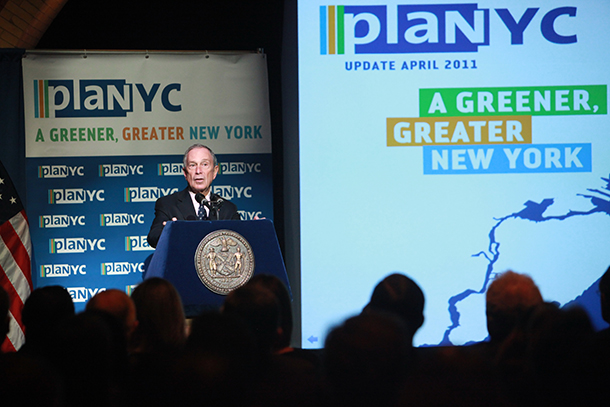
Former New York City Mayor Michael Bloomberg gives an update on PlaNYC, 2011. (Photo: courtesy of the City of New York)
POPE: Yes, we will design the report in a way that you can compare it to both the original Obama submission and to whatever alternative submission Trump makes if he chooses to make one.
CURWOOD: So, Mike Bloomberg is a special envoy of the UN for climate change. To what extent does that become a seat at the table during the climate negotiations since Mr. Trump has taken the federal government come out of that process?
POPE: Well, there's no mechanism by which somebody who is not a representative of a nation-state can have a seat at the negotiating table, but there are mechanisms by which they can interact with the negotiating process. Those have not yet been determined for the next COP at which people will be discussing their commitments. It will be 2020. In 2018, there will there will be a major stocktaking conference, and we'll certainly hoping and envisaging that United Nations will create a seat at the stocktaking process, not only for American cities, but for cities all over the world and for other players like private sector and regions and subnational states.
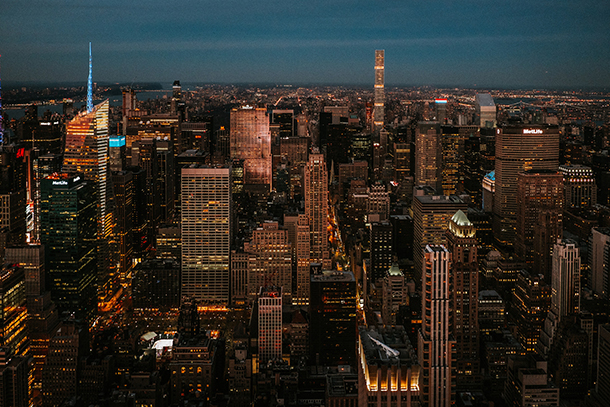
New York City at dusk. Cities including New York are leading the way on reducing greenhouse gas emissions, according to Pope and Bloomberg. (Photo: Jörg Schubert, Flickr CC BY 2.0)
CURWOOD: Carl, what is it about America's governance that makes cities in certain states more likely to take effective climate action than the federal government?
POPE: Well, what makes cities more inclined to take action is quite simply that taking action on climate, the solutions we need to embrace, like renewable power, mass transit, efficient buildings are locally profitable. Cities are the ones who are gonna make the profits and get the benefits from innovation transition, and cities are also by their nature are more innovative than the country as a whole. The national government is torn in multiple directions. We've got certain states, for example, that are very heavily dependent on fossil fuel production. Now, most of the country is an energy consumer not an energy producer, so for most of the country energy efficiency is enormously attractive because it saves money and makes you richer. On the other hand, if you're representing an oil dependent county in Texas or Oklahoma or a coal dependent county in Wyoming, energy efficiency is not such good news because it means lower sales and lower prices.
CURWOOD: As an example, please tell me a bit about the massive effort to green New York City that your co-author Mayor Bloomberg undertook called "PlaNYC".
POPE: "PlaNYC" was Mike Bloomberg's response to the good news he got when he arrived as mayor in New York City that the urban revival had already begun. New York City was going to add a million new people, and when his team brought him, they said, “The good news, Mr. Mayor, is that's going to be good for the city, good for the economy. The bad news is New York City's infrastructure cannot handle a million new people. We are going to have to make a major overhaul of New York City's infrastructure”. And when they looked at doing that, they also reported back to him, “It makes no sense to build things for yesterday's circumstances. We have to get ready for tomorrow”.
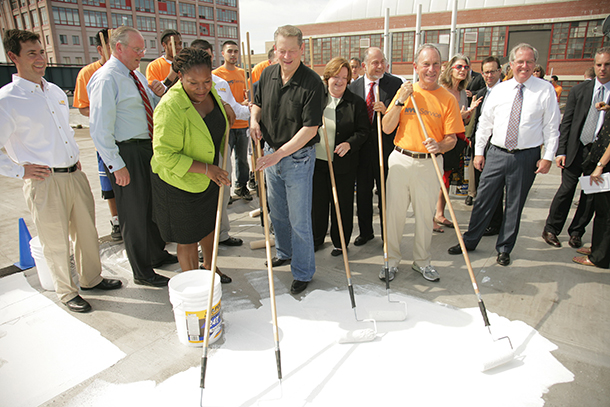
Michael Bloomberg and Al Gore paint a roof white during an event to launch NYC Cool Roofs, 2009. (Photo: courtesy of the City of New York)
So they took the opportunity to make a major rehaul of how New York handled its buildings and its transportation and its solid waste because those were the big three hings the city had control over. And one of Mike's favorite stories was one of the first things he did to encourage this process - the bottom-up process as well as the top-down process - was he and Al Gore went onto the roof of a building, I think in Coney Island, and painted it white as a way of demonstrating to people that you could actually reduce your utility bill on hot summer days a lot by just having a white roof, and, as Mike likes to say, when he used to fly into Kennedy Airport, he would fly over a sea of black asphalt, and now he flies over a sea of white roofs. So, people...They didn't make them do it, everyone did it because it made sense and probably not everybody did it, but most people did.
CURWOOD: So, how can cities finance the projects they need to undertake to do their part to combat climate change? How do you pay for it?
POPE: Well, the thing that's wonderful about these solutions is, they're lucrative. They're profitable. So, cities can borrow money and they will find bankers very eager to lend them the money, and they will be cash-flow positive as they pay the money back because they will be saving more from the innovation than they are paying to pay back the loan. So, for example, if you take a building and when tenants turnover you upgrade it and renovate it, the landlord and the tenant will be making more money because they'll be paying less money for the utility bill, and those savings will pay for the investment in the better windows or the less leaky walls.
CURWOOD: I want to switch subjects for a moment, Carl, and that is to talk about your highly successful effort to shutter coal plants while you were still at the helm of the Sierra Club. Of course, that was certainly aided by the natural gas boom, but still, President Trump says he wants to bring back coal jobs. How confident are you the coal industry will not be revived by Mr. Trump's rhetoric on this?
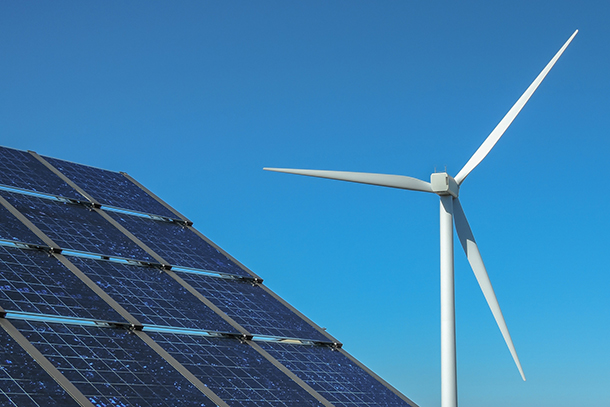
The prices of wind and solar energy are undercutting the cost of energy derived from burning fossil fuels in some parts of the country. (Photo: Ed Suominen, Flickr CC BY-NC 2.0)
POPE: Very confident. And even if the coal industry were to be revived by some unlikely change in international markets, jobs are not coming back because the jobs were in Appalachia. That's where there was coal mining underground. That was the labor-intensive part of the coal industry, and the coal seams in Appalachia are basically played out. Appalachia started losing market share to the Powder River Basin about two years ago because it could no longer compete even domestically for the production of coal. So, the jobs are sadly not coming back. I don't think the coal is coming back either, and Mr. Trump could talk about it but the reality is in a state like Texas producing a kilowatt hour of electricity with coal costs about six cents and producing a kilowatt hour of electricity with natural gas or with wind or with solar costs about three cents. So, the number of people who are willing to pay six cents to get a dirtier fuel is relatively small, and as evidence of this the National Museum of Coal Mining, which is in eastern Kentucky, recently switched its power source from coal to solar because solar energy was $10,000 a year cheaper for the museum.
CURWOOD: So, a lot of people who used to have those really good jobs mining coal…You went down in there, you might make $60,000, $70,000, $80,000, $90,000 a year. They're out of work, you said they're going to stay out of work. Those are not happy voters at this point. How can America embrace these folks who after all, in the previous iteration of our system, they created the support for the industry that we have?
POPE: Well, first I think we have to understand -- Mike and I point this out in "Climate of Hope" -- that the key to climate progress is rapid innovation. The fundamental thing that will determine how successful we are in combating climate change is how fast we innovate and how fast we turn over our capital stocks, but when you innovate and turn over capital stocks, some people are left out and left behind. We need to give those people what Mike and I call climate insurance.
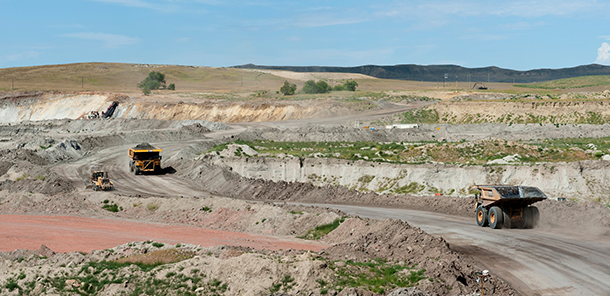
Now that coal seams in the Appalachian region have mostly played out, Wyoming’s Powder River Basin (PRB) has led coal production, providing 40% of America’s coal. But mining the PRB’s surface coal seams is a largely mechanized operation – meaning comparatively few mining jobs. (Photo: Max Phillips / Jeremy Buckingham MLC, Flickr CC BY 2.0)
We need to actually have a society in which, if you happen to be in an industry that is displaced by a more efficient or lower carbon innovation, you have an economic future, your community has a tax base, your pension and your health care are safe. We need to create a better safety net in this country if we’re going to accelerate innovation, which we need to do for climate change, but we also need to do for global competitiveness. Societies without safety nets are not going to do very well in the 21st-century, something the Republican Party doesn't seem to understand.
CURWOOD: So, the book that you just published, "Climate of Hope" with Michael Bloomberg makes the case for local action to preserve our planet. You called it “Climate of Hope”, so this is not all doom and gloom. And as I was reading it, I didn't find a whole lot of doom and gloom. But at the end of day, how can you really be hopeful in the face of…We've got rising seas and temperatures, we have more intense hurricanes, drought, we have political stalemate in many cases, regressive government in others. What gives you hope?
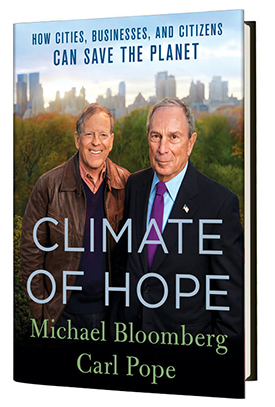
Climate of Hope. (Photo: courtesy of Climate of Hope)
POPE: Now, it is true we have already disrupted the climate. That disruption is going to come with a price. There will be more hurricanes, there will be more floods, there will be more droughts, and we are going to need to replace our current, somewhat brittle, infrastructure with more resilient infrastructure. But overall, the things that we need to do to curb climate change and to eventually reduce concentrations of greenhouse gases in the atmosphere are things that would be very good for us, and they’re things we know how to do. It isn't that hard to clean up the water in New York and let the oysters come back. There was one point in history when the New York metropolitan area had one-third of the world's oyster beds in that area alone. If we go back there, then the next time a hurricane comes, the storm surge will much smaller. So, it is those kinds of reliances on natural ecosystems that are going to enable us to the weather the storms we have unleashed.
CURWOOD: Carl Pope is the former Executive Director for the Sierra Club and senior climate advisor to Michael Bloomberg, the UN Special Envoy to Cities and Climate Change. Carl, thanks so much for taking the time with me today.
POPE: Terrific to be with you.
Links
Bloomberg Philanthropies press release on “America’s Pledge”
NYTimes: “Bucking Trump, These Cities, States and Companies Commit to Paris Accord”
Living on Earth wants to hear from you!
Living on Earth
62 Calef Highway, Suite 212
Lee, NH 03861
Telephone: 617-287-4121
E-mail: comments@loe.org
Newsletter [Click here]
Donate to Living on Earth!
Living on Earth is an independent media program and relies entirely on contributions from listeners and institutions supporting public service. Please donate now to preserve an independent environmental voice.
NewsletterLiving on Earth offers a weekly delivery of the show's rundown to your mailbox. Sign up for our newsletter today!
 Sailors For The Sea: Be the change you want to sea.
Sailors For The Sea: Be the change you want to sea.
 The Grantham Foundation for the Protection of the Environment: Committed to protecting and improving the health of the global environment.
The Grantham Foundation for the Protection of the Environment: Committed to protecting and improving the health of the global environment.
 Contribute to Living on Earth and receive, as our gift to you, an archival print of one of Mark Seth Lender's extraordinary wildlife photographs. Follow the link to see Mark's current collection of photographs.
Contribute to Living on Earth and receive, as our gift to you, an archival print of one of Mark Seth Lender's extraordinary wildlife photographs. Follow the link to see Mark's current collection of photographs.
 Buy a signed copy of Mark Seth Lender's book Smeagull the Seagull & support Living on Earth
Buy a signed copy of Mark Seth Lender's book Smeagull the Seagull & support Living on Earth

